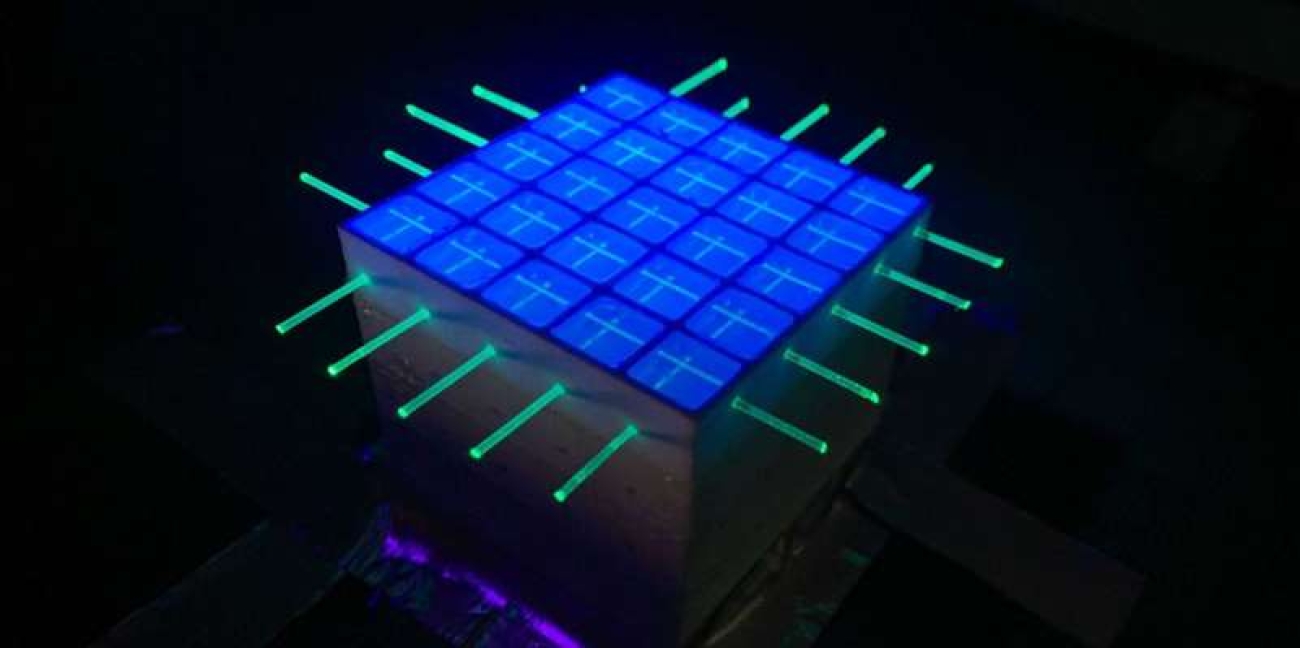Innovative Scintillator Detector Technologies

Plastic scintillator detectors are cost-effective and benefit from a very fast response as well as the possibility to easily shape their geometry. Thus, their deployment is a standard in most of the particle physics experiments. Although their development has reached a limit, a lot more potential can still be extracted.
A clear example is the new concept of neutrino detector based on plastic scintillator, called “Super Fine-Grained Detector” (SuperFGD). Conceived and proposed in 2018[1], it has been constructed as part of the upgrade of the T2K magnetised near detector (ND280)[2], also supported by the CERN Neutrino Platform[3]. Now, SuperFGD is providing detailed 3D images of neutrino interactions at the T2K long-baseline neutrino oscillation experiment in Japan, that searches for hints of leptonic charge-parity (CP) symmetry violation[4]. Made of about 2,000,000 optically-isolated 1 cm3 scintillating cubes, the scintillation light is read out by three orthogonal wavelength shifting (WLS) fibers coupled with about 56,000 silicon photomultipliers (SiPMs). Details of the SuperFGD design, construction and initial performance results were presented in December of last year in the series of “CERN Detector seminars”[5].
Preliminary data analyses confirm the performance of SuperFGD is close to the design expectation. Highlights from the seminar show a candidate muon neutrino charged-current interaction with a proton stopping in the detector (left) and the Bragg peak distribution of selected protons stopping in SuperFGD (middle). Moreover, an event with a final-state neutron with an estimated kinetic energy of 27 MeV was reported (right). With SuperFGD, the T2K collaboration aims to measure, for the first time in a neutrino experiment, the time of flight of neutrons produced by neutrino interactions. Work is in progress to finalise the data analyses towards high-precision measurements of neutrino-nucleus interactions.

The four-year long production and assembly of SuperFGD faced several challenges that could be resolved with careful engineering of both the detector mechanics and the assembly procedure. On the other hand, scaling up this intricate workflow and aiming for finer granularity at future HEP experiments highlights the necessity for technological innovation. Additive manufacturing can be the game changer.
The 3D printed DETector (3DET) R&D Collaboration[6] hosted at CERN is advancing additive manufacturing methods to create detectors with challenging geometries such as SuperFGD[7,8,9]. A major milestone, already reported in [10,11] and published recently[12], showed the production of a monolithic matrix of 5×5×5 optically isolated scintillating cubes crossed by 1.1 mm diameter holes with a pitch of 1 cm using the developed Fused Injection Modeling technique.
Since then, the same prototype underwent multiple tests, including a charged-particle beam test at the T9 beamline of the CERN Proton-Synchrotron (PS). The light yield response was characterised with the use of two hodoscopes made of 1 mm edge scintillating fibers (see below figure on the left). Beam particle events in the prototype were selected by the coincidence of the upstream and downstream hodoscopes (see red dots in the middle figure below). The overall root-mean-square (RMS) of the light yield uniformity within a single cube was found to be approximately 7%. This result points out the high transparency of the 3D printed plastic scintillator[13].

With new developments, the optimisation of the white filament composition allowed us to achieve a reflectivity better than 90% for a 1 mm thick reflector wall[14], as shown in the right figure above. Preliminary studies indicate a 10% increase in the light yield due to the higher reflectivity and an optical cube-to-cube crosstalk of less than 1%.
Efforts at the 3DET collaboration are ongoing towards the first fully-automated 3D printer of plastic scintillator detectors, the 3D printing of neutron-sensitive plastic scintillator and, further in the future, the additive manufacturing of monolithic sampling calorimeters.
Further reading
- A. Blondel et al., “A fully-active fine-grained detector with three readout views”, JINST 13 (2018) no.02, P02006
- K. Abe et al. (T2K Collaboration), “T2K ND280 Upgrade – Technical Design Report”, CERN-SPSC-2019-001 (SPSC-TDR-006)
- C. Giganti, T. Lux, “NP07: ND280 Upgrade status report”, CERN-SPSC-2024-016 ; SPSC-SR-347
- K. Abe et al. (T2K Collaboration), “Constraint on the matter-antimatter symmetry-violating phase in neutrino oscillations”, Nature 580, no.7803, 339–344 (2020)
- D. Sgalaberna for the SuperFGD working group, CERN Detector seminar: “The Super Fine-Grained Detector (SuperFGD) for the T2K neutrino oscillation experiment”, https://indico.cern.ch/event/1484063/
- https://threedet.web.cern.ch
- S. Berns et al, JINST 15 P10019 (2020)
- S. Berns et al, JINST 17 P10045 (2022)
- T. Sibilieva et al, JINST 18 P03007 (2023)
- EP News article
- CERN Courier article
- T. Weber et al., Commun. Eng. 4, 41 (2025)
- B. Li et al., arXiv:2412.10174 [physics.ins-det] (2024)
- D. Sgalaberna for the 3DET collaboration, talk at ICHEP 2024,
